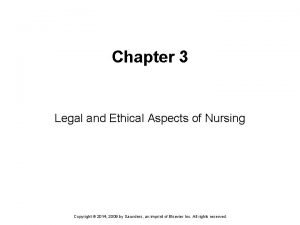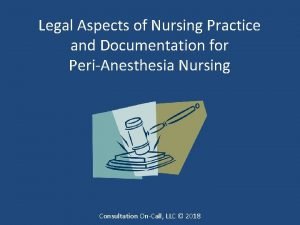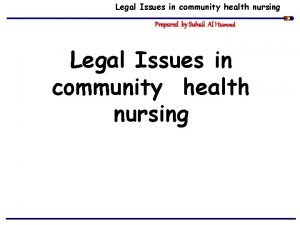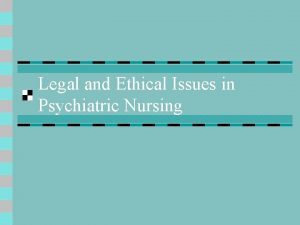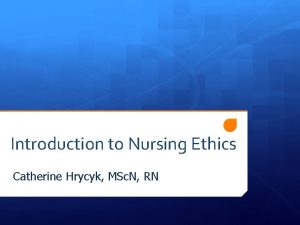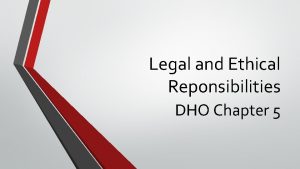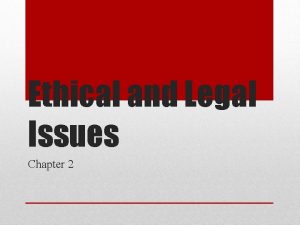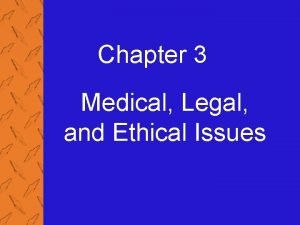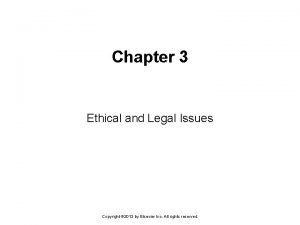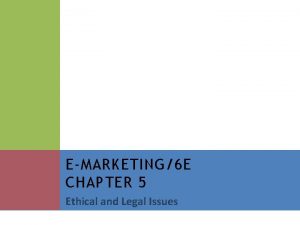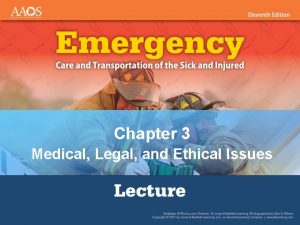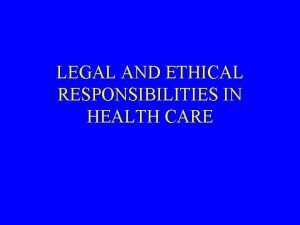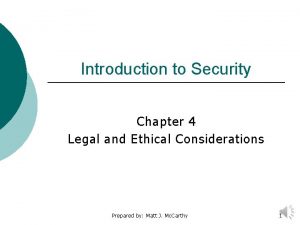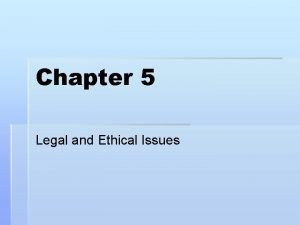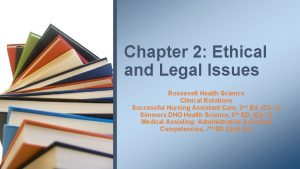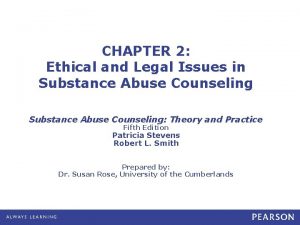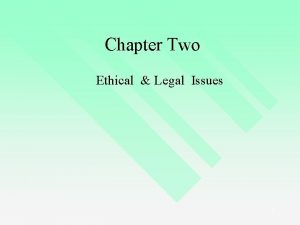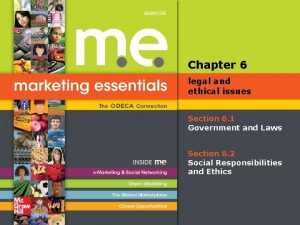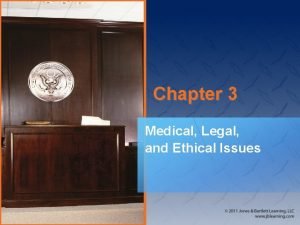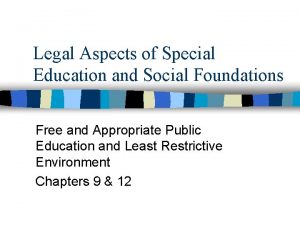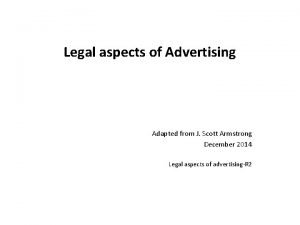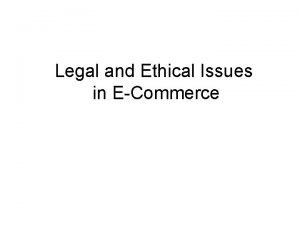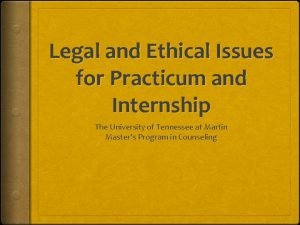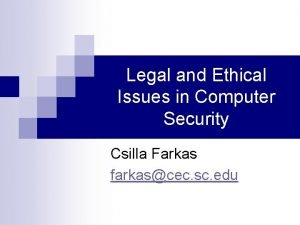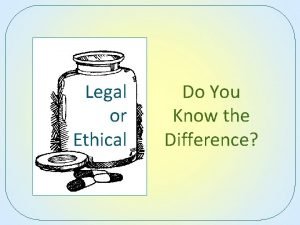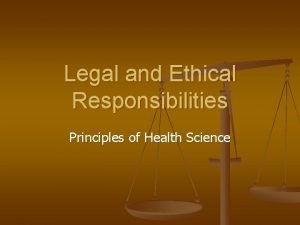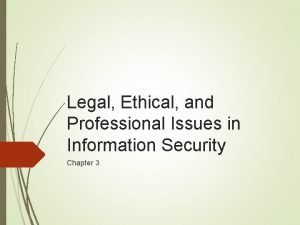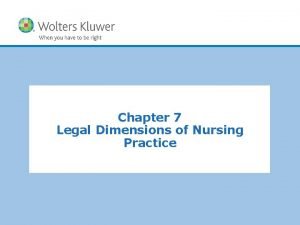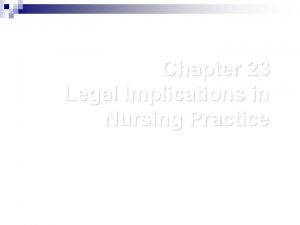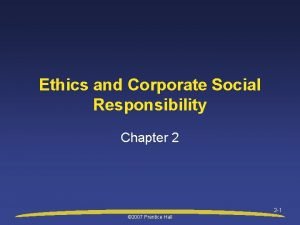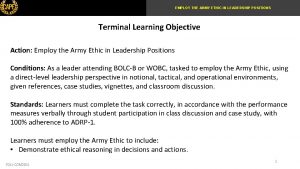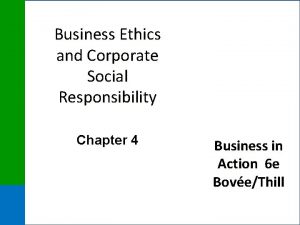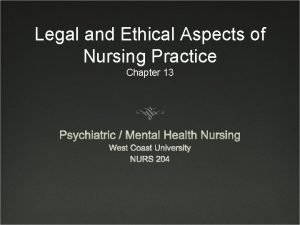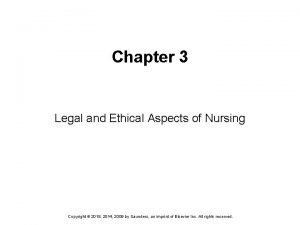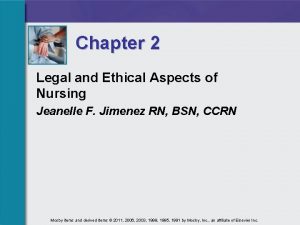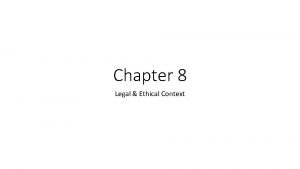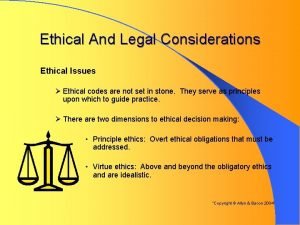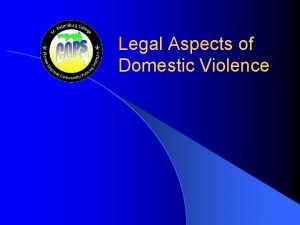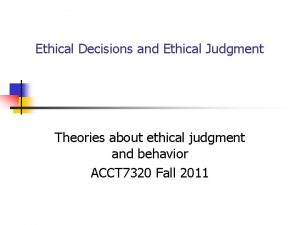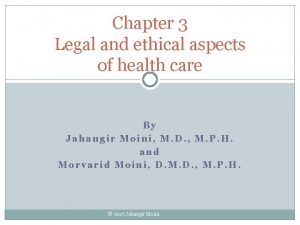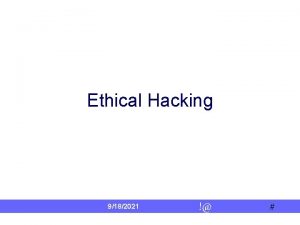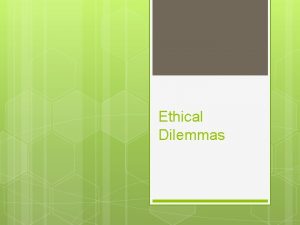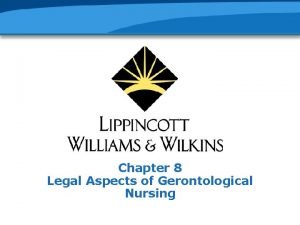Chapter 3 Legal and Ethical Aspects of Nursing


















































- Slides: 50

Chapter 3 Legal and Ethical Aspects of Nursing Copyright © 2014, 2009 by Saunders, an imprint of Elsevier Inc. All rights reserved.

Chapter 3 Lesson 3. 1 Copyright © 2014, 2009 by Saunders, an imprint of Elsevier Inc. All rights reserved.

Learning Objectives Theory 1) Explain the legal requirements for the practice of nursing and how they relate to a student nurse. 2) Identify the consequences of violating the nurse practice act. 3) Examine the issue of professional accountability, professional discipline, and continuing education for licensed nurses. 4) Compare and contrast the terms negligence and malpractice. Copyright © 2014, 2009 by Saunders, an imprint of Elsevier Inc. All rights reserved. Slide 3

Learning Objectives Clinical Practice 1) Reflect on how laws relating to discrimination, workplace safety, child abuse, and sexual harassment affect your nursing practice. 2) Discuss the National Patient Safety Goals and identify where these can be found. 3) Interpret rights that a patient has in a hospital, nursing home, community setting, or psychiatric facility. Copyright © 2014, 2009 by Saunders, an imprint of Elsevier Inc. All rights reserved. Slide 4

Source of Laws are rules of conduct that are established by our government Three sources The Constitution and Bill of Rights Ø Laws made by elected officials Ø Regulations made by agencies created by elected officials Ø Copyright © 2014, 2009 by Saunders, an imprint of Elsevier Inc. All rights reserved. Slide 5

Source of Law (cont’d) Constitutional law provides for basic rights and creates legislative bodies Judicial law results when a law or court decision is challenged and the judge affirms or reverses the decision Administrative law comes from agencies created by the legislature Copyright © 2014, 2009 by Saunders, an imprint of Elsevier Inc. All rights reserved. Slide 6

Civil and Criminal Law Civil law Guarantees individual rights Ø A tort is a violation of civil law Ø Crime A wrong against society Ø Imprisonment and/or fines may result if one is convicted of a crime Ø Copyright © 2014, 2009 by Saunders, an imprint of Elsevier Inc. All rights reserved. Slide 7

Nurse Practice Acts Define the scope of nursing practice Regulate the profession by a state’s board of nursing Include the definition of nursing for the RN and the LPN or LVN and may include definitions for advanced-practice nurses Copyright © 2014, 2009 by Saunders, an imprint of Elsevier Inc. All rights reserved. Slide 8

Licensure Eligibility determined by state’s board of nursing Each state sends a representative to the National Council of the State Boards of Nursing, which develops the National Council Licensure Examination (NCLEX)® Passing score on NCLEX-PN® is accepted in all states as one requirement for licensure Reciprocity, nurse licensure compacts, or recognition of one state’s nursing license by another state is a current issue Copyright © 2014, 2009 by Saunders, an imprint of Elsevier Inc. All rights reserved. Slide 9

Student Nurses Held to the same standards as a licensed nurse Legally responsible for their own actions or inaction Have responsibility to consult with instructor when unsure in a situation, or when patient’s condition is changing rapidly Need to know their state’s nurse practice act Copyright © 2014, 2009 by Saunders, an imprint of Elsevier Inc. All rights reserved. Slide 10

Professional Accountability Nurse’s responsibility to meet health care needs of patient in a safe and caring way Students must apply classroom learning and theory in the clinical setting Accountability entails a commitment to stay current and knowledgeable Copyright © 2014, 2009 by Saunders, an imprint of Elsevier Inc. All rights reserved. Slide 11

Delegation The assignment of duties to another person LPN may supervise nursing assistants, technicians, or other LPNs Delegating nurse’s duty is to supervise and evaluate care that a licensed or unlicensed person provides Copyright © 2014, 2009 by Saunders, an imprint of Elsevier Inc. All rights reserved. Slide 12

Professional Discipline State boards of nursing are responsible for discipline within the profession Most common charges brought against nurses include substance abuse, incompetence, and negligence It is considered negligence not to report another professional’s misconduct Copyright © 2014, 2009 by Saunders, an imprint of Elsevier Inc. All rights reserved. Slide 13

Continuing Education Many states have laws that require evidence of continuing education after a nurse has passed the licensing exam Nurses must continue their education to keep abreast of changes in health care practice, pharmacology, and technology in order to practice safely Copyright © 2014, 2009 by Saunders, an imprint of Elsevier Inc. All rights reserved. Slide 14

Laws and Guidelines Affecting Nursing Practice Occupational Safety and Health Act Child Abuse Prevention and Treatment Act Discrimination Sexual harassment Good Samaritan laws Patients’ Rights National Patient Safety Goals Health Insurance Portability and Accountability Act (HIPAA) Consents and releases Copyright © 2014, 2009 by Saunders, an imprint of Elsevier Inc. All rights reserved. Slide 15

Occupational Safety and Health Administration (OSHA) Regulations on handling infectious/toxic materials, radiation safeguards, and electrical equipment Requires orientation and education in topics such as blood-borne pathogens, exposure, fire, bomb threats, lifting, and evacuation procedures Requires facilities to keep a record of hazardous substances as well as material safety data sheets (MSDS) Copyright © 2014, 2009 by Saunders, an imprint of Elsevier Inc. All rights reserved. Slide 16

Child Abuse Prevention and Treatment Act (CAPTA) Defines child abuse and neglect Ø “Any recent act, or failure to act, that results in imminent risk of serious harm, death, serious physical or emotional harm, sexual abuse, or exploitation of a child by a parent or caretaker who is responsible for the child’s welfare” Licensed health care personnel required to report child abuse Copyright © 2014, 2009 by Saunders, an imprint of Elsevier Inc. All rights reserved. Slide 17

Discrimination Making a decision or treating a person based on a class or group to which he belongs, such as race, religion, or sex, rather than on his individual qualities Illegal for employers to ask questions on an employment application that would indicate race or other protected categories, or health status Copyright © 2014, 2009 by Saunders, an imprint of Elsevier Inc. All rights reserved. Slide 18

Sexual Harassment Unwelcome sexual advances, requests for sexual favors, and other verbal or physical conduct of a sexual nature Illegal when used as a condition of employment or promotion or when it interferes with job performance Copyright © 2014, 2009 by Saunders, an imprint of Elsevier Inc. All rights reserved. Slide 19

Good Samaritan Laws Protect a health care professional from liability if he stops to provide aid in an emergency Liability is limited unless there is evidence of gross negligence or intentional misconduct Copyright © 2014, 2009 by Saunders, an imprint of Elsevier Inc. All rights reserved. Slide 20

Patient’s Rights Revised to “The Patient Care Partnership: Understanding Expectations, Rights, and Responsibilities” in 2003 An ethical, not a legal, document Seeks to preserve patient’s dignity, privacy, freedom of movement, and information needs State legislators have written laws that prohibit certain actions or guarantee particular rights Copyright © 2014, 2009 by Saunders, an imprint of Elsevier Inc. All rights reserved. Slide 21

National Patient Safety Goals Provide evidence- and expert-based solutions to problem areas in terms of patient safety Sentinel event An unexpected patient care event that results in death or serious injury (or risk thereof) to the patient Ø Most frequent cause is lack of communication among caregivers Ø Copyright © 2014, 2009 by Saunders, an imprint of Elsevier Inc. All rights reserved. Slide 22

Negligence and Malpractice Negligence Ø Failing to do something a reasonably prudent person would do, or doing something a reasonably prudent person would NOT do Malpractice Negligence by a professional person Ø Not acting according to professional standards of care as a reasonably prudent professional would Ø Copyright © 2014, 2009 by Saunders, an imprint of Elsevier Inc. All rights reserved. Slide 23

Question 1 Universal guidelines are developed for all nursing interventions, which define appropriate measures that should be observed during the performance of those interventions. These are known as: 3) scope of practice. advocacy. standard of care. 4) prudent practice. 1) 2) Copyright © 2014, 2009 by Saunders, an imprint of Elsevier Inc. All rights reserved. Slide 24

Chapter 3 Lesson 3. 2 Copyright © 2014, 2009 by Saunders, an imprint of Elsevier Inc. All rights reserved.

Learning Objectives Theory 5) Discuss what you can do to protect yourself from lawsuits or the damage of lawsuits. 6) Differentiate a code of ethics from laws or regulations governing nursing, and compare the similarities of the codes of ethics from the NFLPN, NAPNES, and ANA. 7) Describe the NAPNES standards of practice. Copyright © 2014, 2009 by Saunders, an imprint of Elsevier Inc. All rights reserved. Slide 26

Learning Objectives 4) 5) Clinical Practice Describe three factors necessary for informed consent. Explain advance directives and the advantage of having them written out. Copyright © 2014, 2009 by Saunders, an imprint of Elsevier Inc. All rights reserved. Slide 27

The Chart or Medical Record A legal document that includes records of all assessments, tests, and care provided Kept confidential Only people directly associated with the care of that patient have legal access to information in the chart Property of the hospital, agency, or physician, not the patient Copyright © 2014, 2009 by Saunders, an imprint of Elsevier Inc. All rights reserved. Slide 28

Health Insurance Portability and Accountability Act (HIPAA) Regulations regarding patient privacy and electronic medical records Failure to comply with the rules may lead to civil penalties Intentional violation of the regulations can lead to sizable fines and time in jail Copyright © 2014, 2009 by Saunders, an imprint of Elsevier Inc. All rights reserved. Slide 29

Consent Legal document that records the patient’s permission to perform a treatment or surgery, or to give information to insurance companies or other health care providers Informed consent Indicates patient’s participation in decision making Ø Person signing must know what the consent allows and be able to make a knowledgeable decision Ø Copyright © 2014, 2009 by Saunders, an imprint of Elsevier Inc. All rights reserved. Slide 30

Release Legal form to excuse one party from liability Common release is a Leave Against Medical Advice (Leave AMA) May also refer to forms used to authorize an agency to send confidential health care information to another agency, school, or insurance company Copyright © 2014, 2009 by Saunders, an imprint of Elsevier Inc. All rights reserved. Slide 31

Witnessing Wills or Other Legal Documents Most hospitals and health care agencies have policies against witnessing wills or legal documents If will is contested, nurse could be called to testify regarding the patient’s health or mental condition, or relationship to visitors Copyright © 2014, 2009 by Saunders, an imprint of Elsevier Inc. All rights reserved. Slide 32

Advance Directives Allow a person to plan for/communicate medical wishes if unable to do so himself Durable power of attorney Gives legal power to a health care agent Ø Person is chosen by the patient to follow the patient’s advance directives and make medical decisions on his behalf Ø Copyright © 2014, 2009 by Saunders, an imprint of Elsevier Inc. All rights reserved. Slide 33

Common Legal Issues Nurses have access to private information and personal contact When legal boundaries are violated, and injury occurs, nurses may be subject to litigation Copyright © 2014, 2009 by Saunders, an imprint of Elsevier Inc. All rights reserved. Slide 34

Assault and Battery Assault Ø The threat to harm another, or even to threaten to touch another without that person’s permission Battery Ø Actual physical contact that has been refused or that is carried out against the person’s will Copyright © 2014, 2009 by Saunders, an imprint of Elsevier Inc. All rights reserved. Slide 35

Defamation One person makes remarks about another person that are untrue, and the remarks damage that other person’s reputation Two types Slander (oral) Ø Libel (written) Ø Copyright © 2014, 2009 by Saunders, an imprint of Elsevier Inc. All rights reserved. Slide 36

Invasion of Privacy A violation of the confidential and privileged nature of a professional relationship Unauthorized persons learn of the patient’s history, condition, or treatment from the professional caregiver Leaves patients in a position that might cause loss of dignity or embarrassment Copyright © 2014, 2009 by Saunders, an imprint of Elsevier Inc. All rights reserved. Slide 37

False Imprisonment Preventing a person from leaving, or restricting movements in the facility When involuntary admission is made against patient’s wishes, to protect him from self-harm or from harming others, he may be detained without consent for a short time Copyright © 2014, 2009 by Saunders, an imprint of Elsevier Inc. All rights reserved. Slide 38

Protective Devices The inappropriate use of devices that limit a person’s mobility can result in charges of false imprisonment Devices may be mechanical or chemical Physician order needed for any protective device Copyright © 2014, 2009 by Saunders, an imprint of Elsevier Inc. All rights reserved. Slide 39

Decreasing Legal Risk Nursing competence Incident or occurrence reports Liability insurance Copyright © 2014, 2009 by Saunders, an imprint of Elsevier Inc. All rights reserved. Slide 40

Nursing Competence Possessing skill, knowledge, and experience necessary to provide adequate nursing care Documentation: key in proving nursing actions used were appropriate, protecting nurse from liability Lawsuits may be avoided by early identification of dissatisfied patients Copyright © 2014, 2009 by Saunders, an imprint of Elsevier Inc. All rights reserved. Slide 41

Incident or Occurrence Reports Document occurrence that is out of the ordinary Document what happened, the facts about the incident, and who was involved or witnessed it Generally not filed as part of the patient’s chart; no reference to the incident report is made in the patient’s chart Copyright © 2014, 2009 by Saunders, an imprint of Elsevier Inc. All rights reserved. Slide 42

Liability Insurance Protects the livelihood and assets of a nurse should the nurse get sued Pays for a lawyer to defend the nurse and any award won by plaintiff up to limits of the policy May also pay for attorney costs and related costs if the nurse is subjected to review by the state board of nursing Copyright © 2014, 2009 by Saunders, an imprint of Elsevier Inc. All rights reserved. Slide 43

Ethics in Nursing Ethics are rules of conduct that have been agreed to by a particular group These rules are agreed to be morally right or proper for that group Ethics are different from laws, in that they are voluntary Copyright © 2014, 2009 by Saunders, an imprint of Elsevier Inc. All rights reserved. Slide 44

Codes of Ethics A respect for human dignity, the individual, and provision of nursing care that is not affected by race, religion, lifestyle, or culture A commitment to continuing education, maintaining competence, and contributing to improved practice The confidential nature of the nurse-patient relationship, outlining behaviors that bring credit to the profession and protect the public Copyright © 2014, 2009 by Saunders, an imprint of Elsevier Inc. All rights reserved. Slide 45

Ethical Dilemmas Life-prolonging treatment versus refusing such treatment Initiating or terminating life support or treatment Assisted suicide Euthanasia Copyright © 2014, 2009 by Saunders, an imprint of Elsevier Inc. All rights reserved. Slide 46

Standards of Care Provide a way of judging the quality and effectiveness of patient care In legal cases, determine whether a nurse acted correctly Copyright © 2014, 2009 by Saunders, an imprint of Elsevier Inc. All rights reserved. Slide 47

Question 2 Since a nurse’s first duty is to the patient’s health, safety, and well-being, it is necessary to report: 1) 2) 3) 4) unethical behavior. a worker who arrives late. favoritism. arguments among the staff. Copyright © 2014, 2009 by Saunders, an imprint of Elsevier Inc. All rights reserved. Slide 48

Question 3 Malpractice is negligence by a professional person. In other words, the person does not according to professional standards of care as a reasonably prudent professional would under the same or similar circumstances. In order to prove malpractice, four elements must be present. Which of the following is not an element of malpractice? 1) 2) 3) 4) Defamation Duty Breach of duty Causation Copyright © 2014, 2009 by Saunders, an imprint of Elsevier Inc. All rights reserved. Slide 49

Question 4 When Mrs. Tingle, age 82, is admitted, the nurse notices bruises all over her body and suspects elder abuse. She may report her suspicions to everyone except the: 1) 2) 3) 4) supervisor. police. family. appropriate agency. Copyright © 2014, 2009 by Saunders, an imprint of Elsevier Inc. All rights reserved. Slide 50
 Chapter 2 legal and ethical aspects of nursing
Chapter 2 legal and ethical aspects of nursing State legal ethical and professional aspects of security
State legal ethical and professional aspects of security Legal issues in nursing documentation
Legal issues in nursing documentation Scbon
Scbon Ethical and legal issues affecting the nursing assistant
Ethical and legal issues affecting the nursing assistant Legal aspects of community health
Legal aspects of community health Ethical and legal issues in psychiatric nursing
Ethical and legal issues in psychiatric nursing Beneficence
Beneficence Dho chapter 5 legal and ethical responsibilities
Dho chapter 5 legal and ethical responsibilities Ethical and legal issues chapter 2
Ethical and legal issues chapter 2 Chapter 3 medical legal and ethical issues
Chapter 3 medical legal and ethical issues Legal and ethical issues chapter 3
Legal and ethical issues chapter 3 Ch 5 legal and ethical responsibilities
Ch 5 legal and ethical responsibilities Legal and ethical issues chapter 5
Legal and ethical issues chapter 5 Legal and ethical issues chapter 3
Legal and ethical issues chapter 3 Chapter 5 legal and ethical responsibilities key terms
Chapter 5 legal and ethical responsibilities key terms Chapter 4 legal and ethical responsibilities
Chapter 4 legal and ethical responsibilities Chapter 6 legal and ethical issues
Chapter 6 legal and ethical issues Legal and ethical issues chapter 5
Legal and ethical issues chapter 5 Chapter 2 ethical and legal issues
Chapter 2 ethical and legal issues Chapter 2 ethical and legal issues
Chapter 2 ethical and legal issues Nonmaleficence
Nonmaleficence Legal and ethical issues chapter 5
Legal and ethical issues chapter 5 Chapter 2 ethical and legal issues
Chapter 2 ethical and legal issues Chapter 6 legal and ethical issues
Chapter 6 legal and ethical issues Chapter 6 legal and ethical issues
Chapter 6 legal and ethical issues Medical legal and ethical issues chapter 3
Medical legal and ethical issues chapter 3 Legal and ethical issues in media
Legal and ethical issues in media Legal aspects of catering premises
Legal aspects of catering premises Mario full screen
Mario full screen Legal aspects of doing business in canada
Legal aspects of doing business in canada Irving isd v tatro
Irving isd v tatro Legal aspects of advertising
Legal aspects of advertising Manajemen pembangunan proyek adalah
Manajemen pembangunan proyek adalah Legal aspects definition
Legal aspects definition Ethical habits
Ethical habits Legal and ethical issues in use of ict
Legal and ethical issues in use of ict Legal and ethical issues in ecommerce
Legal and ethical issues in ecommerce Legal and ethical issues in computer security
Legal and ethical issues in computer security Professional and ethical issues during internship
Professional and ethical issues during internship Legal and ethical issues in computer security
Legal and ethical issues in computer security Legal and ethical responsibilities of a coach
Legal and ethical responsibilities of a coach What is the difference between ethical and legal issues
What is the difference between ethical and legal issues What ishipaa
What ishipaa The legal and ethical environment of business
The legal and ethical environment of business Legal and ethical issues in information security
Legal and ethical issues in information security Legal safeguards for nurses
Legal safeguards for nurses Legal implications of nursing documentation
Legal implications of nursing documentation Perbedaan ethical dilemma dan ethical lapse
Perbedaan ethical dilemma dan ethical lapse Ethical lenses army
Ethical lenses army Perspectives of csr
Perspectives of csr
